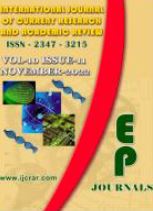Abstract Volume:10 Issue-11 Year-2022 Original Research Articles
 |
Online ISSN : 2347 - 3215 Issues : 12 per year Publisher : Excellent Publishers Email : editorijcret@gmail.com |
This experiment was carried out for two consecutive growing seasons (2012 and 2013) at the Boloso Bombe model in farmer land, Ambe Kebele, to investigate the response of leek variety (Hybrid F1) yield to different mulch materials and weeding-frequency. A split plot experiment was laid out in a randomized complete block design (RCBD) with three replications to randomize the weeding-frequency levels and mulch materials in the main and sub-plots, respectively. The experiment comprised of two weeding-frequency levels, i.e. weeding-frequency (WF) and no-weeding (NWF) and six mulch materials, i.e. black polyethylene, white polyethylene, maize straw, palm fronts, grasses and no mulch. The parameters taken on soil physical and chemical properties are soil moisture content (%), soil temperature (OC), soil pH, total nitrogen, available phosphorus and soil organic matter. Growth and yield parameters taken are as follows: average plant height, number of leaves, and number of leek pseudo stem, stem girth, number of shaft(white part) per plant, shaft(white part) length, shaft(white part) diameter and yield per land area. Weeds were identified and their dry weights were measured. Data were collected from ten randomly selected plants in each plot. The data were statistically analysed using SAS. The analysis of variance (ANOVA) was performed to find out the significance of variation among the treatments while the significant difference between mean treatments were separated using Duncan’s multiple range test at 5% level of probability. The result obtained from this study indicated that mulch materials and strong weeding-frequency affect significantly growth parameters of leek, yield per plant and yield per land area. The result also, indicated that plot mulch with black polythene performance best in terms of growth and yield and also improved soil physical properties better than either white polythene or organic mulch in the study area. It is therefore recommended that black polyethylene should be used as mulch materials for leek production. However, better and stable shaft (white part) yield of leek could be obtained with the practice of mulching in combination with weeding-frequency frequency. It is recommended that mulching should be carried out together with weeding-frequency for higher shaft (white part) yield and black polyethylene should be use as mulch material in the study area.
How to cite this article:
Birhanu Lencha. 2022. Response of Leek Variety (Hybrid F1/Carentan) Yield to Different Mulch Materials and Weeding-Frequency at Ambe Kebele Wolaita Zone.Int.J.Curr.Res.Aca.Rev. 10(11): 63-70doi: https://doi.org/10.20546/ijcrar.2022.1011.007



Quick Navigation
- Print Article
- Full Text PDF
- How to Cite this Article
- on Google
- on Google Scholor
- Citation Alert By Google Scholar
